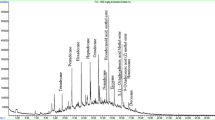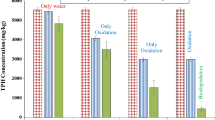Abstract
A soil contaminated with a B20 biodiesel blend (20 % biodiesel, 80 % diesel) has been treated by modified Fenton process with or without chelant addition. All experiments were conducted without pH adjustment. The reagents used were as follows: hydrogen peroxide as oxidant (400–4,000 mmol L−1), ferric ion as catalyst (5–20 mmol L−1), and trisodium citrate (50 mmol L−1) as chelating agent. Soil was spiked at two different pollutant concentrations (1,000–10,000 mg diesel kg−1 soil). Higher total petroleum hydrocarbon (TPH) removal efficiencies were obtained (up to 75 %) after the treatment in the absence of the chelant due to the low pH obtained in this case. In the presence of chelant, the TPH conversion obtained was lower because both higher pH is obtained and chelant competes with diesel for the oxidant. On the other hand, at neutral pH, the lifetime of the oxidant was increased. Fatty acid methyl esters (FAMEs) are easier to remove than diesel aliphatic hydrocarbons from the blend. An important decrease of the aqueous phase toxicity was observed after the modified Fenton reaction, supporting that nontoxic by-products were released to the aqueous phase during the treatment.










Similar content being viewed by others
References
Burriel F, Lucena F, Arribas S, Hernández J (1985) Qualitative analytical chemistry. Paraninfo, Madrid (In Spanish)
Cai XD, Du WT, Wu JY, Li RF, Guo Y, Yang ZJ (2012) Effective treatment of trichloroethylene-contaminated soil by hydrogen peroxide in soil slurries. Pedosphere 22(4):572–579
Chang YY, Roh H, Yang JK (2013) Improving the clean-up efficiency of field soil contaminated with diesel oil by the application of stabilizers. Environ Technol 34(11):1481–1487. doi:10.1080/09593330.2012.758658
Feng XN, Wang ZP, Chen Y, Tao T, Wu F, Zuo YG (2012) Effect of Fe(III)/citrate concentrations and ratio on the photoproduction of hydroxyl radicals: application on the degradation of diphenhydramine. Ind Eng Chem Res 51(20):7007–7012. doi:10.1021/ie300360p
Jho E, Singhal N, Turner S (2012) Tetrachloroethylene and hexachloroethane degradation in Fe(III) and Fe(III)-citrate catalyzed Fenton systems. J Chem Technol Biotechnol 87(8):1179–1186. doi:10.1002/jctb.3746
Kong SH, Watts RJ, Choi JH (1998) Treatment of petroleum-contaminated soils using iron mineral catalyzed hydrogen peroxide. Chemosphere 37(8):1473–1482. doi:10.1016/s0045-6535(98)00137-4
Leme DM, Grummt T, Heinze R, Sehr A, Skerswetat M, de Marchi MRR, Machado MC, de Oliveira DP, Marin-Morales MA (2011) Cytotoxicity of water-soluble fraction from biodiesel and its diesel blends to human cell lines. Ecotoxicol Environ Saf 74(8):2148–2155. doi:10.1016/j.ecoenv.2011.08.012
Leme DM, Grummt T, Heinze R, Sehr A, Renz S, Reinel S, de Oliveira DP, Ferraz ERA, de Marchi MRR, Machado MC, Zocolo GJ, Marin-Morales MA (2012) An overview of biodiesel soil pollution: data based on cytotoxicity and genotoxicity assessments. J Hazard Mater 199:343–349. doi:10.1016/j.jhazmat.2011.11.026
Lewis S, Lynch A, Bachas L, Hampson S, Ormsbee L, Bhattacharyya D (2009) Chelate-modified Fenton reaction for the degradation of trichloroethylene in aqueous and two-phase systems. Environ Eng Sci 26(4):849–859. doi:10.1089/ees.2008.0277
Li YC, Bachas LG, Bhattacharyya D (2007) Selected chloro-organic detoxifications by polychelate (Poly(acrylic acid)) and citrate-based Fenton reaction at neutral pH environment. Ind Eng Chem Res 46(24):7984–7992. doi:10.1021/ie070393b
Mitre TK, Leao MMD, Alvarenga MCN (2013) Treatment of water contaminated by diesel/biodiesel using Fenton process. Eng Sanit Ambient 17(2):129–136
Molina-Barahona L, Vega-Loyo L, Guerrero M, Ramirez S, Romero I, Vega-Jarquin C, Albores A (2005) Ecotoxicological evaluation of diesel-contaminated soil before and after a bioremediation process. Environ Toxicol 20:100–109
Ndounla J, Kenfack S, Wéthé J, Pulgarin C (2014) Relevant impact of irradiance (vs. dose) and evolution of pH and mineral nitrogen compounds during natural water disinfection by photo-Fenton in a solar CPC reactor. Appl Catal B Environ 148–149(0):144–153. doi:10.1016/j.apcatb.2013.10.048
Newell CJ, Acree SD, Ross RR, Huling SG (1995) Light nonaqueous phase liquids, U.S. Environmental Protection Agency Ground Water Issue Paper, R.S. Kerr Environmental Research Laboratory, Ada OK. EPA/540/S-95/500
Pinedo J, Ibanez R, Lijzen JPA, Irabien A (2013) Assessment of soil pollution based on total petroleum hydrocarbons and individual oil substances. J Environ Manag 130:72–79. doi:10.1016/j.jenvman.2013.08.048
Rastogi A, Al-Abed SR, Dionysiou DD (2009) Effect of inorganic, synthetic and naturally occurring chelating agents on Fe(II) mediated advanced oxidation of chlorophenols. Water Res 43(3):684–694. doi:10.1016/j.watres.2008.10.045
Restrepo-Florez JM, Bassi A, Rehmann L, Thompson MR (2013) Effect of biodiesel addition on microbial community structure in a simulated fuel storage system. Bioresour Technol 147:456–463. doi:10.1016/j.biortech.2013.08.068
Romero A, Santos A, Tojo J, Rodriguez A (2008) Toxicity and biodegradability of imidazolium ionic liquids. J Hazard Mater 151(1):268–273. doi:10.1016/j.jhazmat.2007.10.079
Rosas JM, Vicente F, Saguillo EG, Santos A, Romero A (2014) Remediation of soil polluted with herbicides by Fenton-like reaction: kinetic model of diuron degradation. Appl Catal B Environ 144:252–260. doi:10.1016/j.apcatb.2013.07.011
Shin KH, Jung HY, Chang PC, Choi HC, Kim KW (2005) Earthworm toxicity during chemical oxidation of diesel-contaminated sand. Environ Toxicol Chem 24:1924–1929
Sillanpaa MET, Kurniawan TA, Lo WH (2011) Degradation of chelating agents in aqueous solution using advanced oxidation process (AOP). Chemosphere 83(11):1443–1460. doi:10.1016/j.chemosphere.2011.01.007
Sun YF, Pignatello JJ (1992) Chemical treatment of pesticide wastes—evaluation of Fe(III) chelates for catalytic hydrogen-peroxide oxidation of 2,4-D at circumneutral PH. J Agric Food Chem 40(2):322–327. doi:10.1021/jf00014a031
Tang JC, Lu XQ, Sun Q, Zhu WY (2012) Aging effect of petroleum hydrocarbons in soil under different attenuation conditions. Agric Ecosyst Environ 149:109–117. doi:10.1016/j.agee.2011.12.020
Tsai TT, Kao CM (2009) Treatment of petroleum-hydrocarbon contaminated soils using hydrogen peroxide oxidation catalyzed by waste basic oxygen furnace slag. J Hazard Mater 170(1):466–472. doi:10.1016/j.jhazmat.2009.04.073
U.S. Department of Health and Human Services (1995) Toxicological profile for fuel oils. Public Health Service Agency for Toxic Substances and Disease Registry
Venny, Gan SY, Ng HK (2012) Inorganic chelated modified-Fenton treatment of polycyclic aromatic hydrocarbon (PAH)-contaminated soils. Chem Eng J 180:1–8. doi:10.1016/j.cej.2011.10.082
Vicente F, Rosas JM, Santos A, Romero A (2011) Improvement soil remediation by using stabilizers and chelating agents in a Fenton-like process. Chem Eng J 172(2–3):689–697. doi:10.1016/j.cej.2011.06.036
Vicente F, Santos A, Saguillo EG, Martinez-Villacorta AM, Rosas JM, Romero A (2012) Diuron abatement in contaminated soil using Fenton-like process. Chem Eng J 183:357–364. doi:10.1016/j.cej.2012.01.010
Villa RD, Trovo AG, Nogueira RFP (2010) Diesel degradation in soil by Fenton process. J Braz Chem Soc 21(6):1088–1095
Watts RJ, Dilly SE (1996) Evaluation of iron catalysts for the Fenton-like remediation of diesel-contaminated soils. J Hazard Mater 51(1–3):209–224. doi:10.1016/s0304-3894(96)01827-4
Watts RJ, Teel AL (2005) Chemistry of modified Fenton’s reagent (catalyzed H2O2 propagations-CHP) for in situ soil and groundwater remediation. J Environ Eng 131:612–622
Watts RJ, Teel AL (2006) Treatment of contaminated soils and groundwater using ISCO. Pract Period Hazard Toxicol Radioact Waste Manag 10:2–9
Xu JL, Pancras T, Grotenhuis T (2011) Chemical oxidation of cable insulating oil contaminated soil. Chemosphere 84(2):272–277. doi:10.1016/j.chemosphere.2011.03.044
Xue XF, Hanna K, Despas C, Wu F, Deng NS (2009) Effect of chelating agent on the oxidation rate of PCP in the magnetite/H2O2 system at neutral pH. J Mol Catal A Chem 311(1–2):29–35. doi:10.1016/j.molcata.2009.06.016
Yen CH, Chen KF, Kao CM, Liang SH, Chen TY (2011) Application of persulfate to remediate petroleum hydrocarbon-contaminated soil: feasibility and comparison with common oxidants. J Hazard Mater 186(2–3):2097–2102. doi:10.1016/j.jhazmat.2010.12.129
Zhao D, Yan X-l, Liao X-y, Tu S-x, Shi Q-w (2011) Chemical oxidants for remediation of BTEX-contaminated soils at coking sites. Huanjing Kexue 32(3):849–856
Acknowledgments
The authors acknowledge financial support from the Comunidad Autonomy de Madrid provided throughout project CARESOIL (S2009AMB-1648) and from the Spanish Ministry of Science and Innovation, project CTM2010-16693.
Author information
Authors and Affiliations
Corresponding author
Additional information
Responsible editor: Philippe Garrigues
Rights and permissions
About this article
Cite this article
Pardo, F., Rosas, J.M., Santos, A. et al. Remediation of a biodiesel blend-contaminated soil by using a modified Fenton process. Environ Sci Pollut Res 21, 12198–12207 (2014). https://doi.org/10.1007/s11356-014-2997-2
Received:
Accepted:
Published:
Issue Date:
DOI: https://doi.org/10.1007/s11356-014-2997-2




